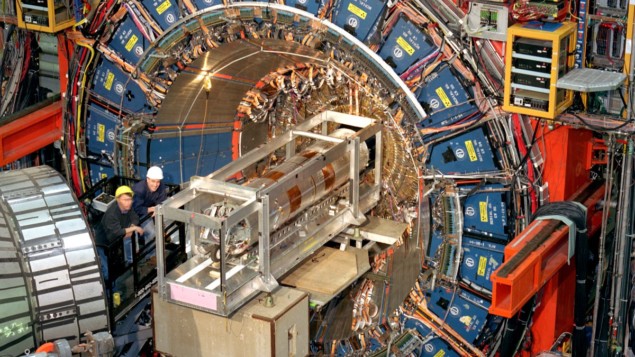W boson mass measurement surprises physicists
08 Apr 2022

The most precise measurement to date of the mass of the W boson has yielded a result seven standard deviations away from that predicted by the Standard Model of particle physics. The stunning result was obtained by a painstaking analysis of data taken at the Fermilab Tevatron collider in the US before it closed in 2011. The particle physics community must now study the results carefully to work out whether it is an incredible statistical fluke, an unknown experimental error, a flaw in the Standard Model or a genuine indication of physics beyond the Standard Model.
The W boson is one of the most intriguing particles described by the Standard Model. Together with the neutral Z boson, the charged W boson mediates the weak interaction, which causes beta decay and several other important processes in particle physics. The weak interaction has long intrigued scientists searching for physics beyond the Standard Model, partly because it is the only force known to violate charge-parity symmetry. If particles in a process are exchanged for their antiparticles and the spatial co-ordinates are inverted, the weak interaction in this mirror image process are not always identical. This puzzle is not explained in the Standard Model.
The weak interaction is also unique in that, whereas the photons that mediate electromagnetism and the gluons that mediate the strong interaction are massless, the W and Z bosons have mass. The Standard Model does not predict the absolute mass of the W boson directly, but it does predict the ratio between the masses of the W and Z bosons. To make absolute predictions, however, physicists needed to know the mass of the Higgs boson, which was not known when Tevatron switched off in 2011. The very next year, however, CERN’s new Large Hadron Collider famously discovered the missing boson at a mass of 125.35 GeV.
Encouraging measurements
“The Z boson mass was measured already much more precisely than the W,” explains Ashutosh Kotwal of Duke University in the US, who is part of the Collider Detector at Fermilab (CDF) collaboration, which was one of two experiments at the Tevatron. “That’s one of the things that’s been driving us: if you know the Z boson mass precisely, that allows you to calculate the W boson mass precisely, because it’s the connection that the theory tells you.” The Higgs boson mass allowed physicists to infer that the mass of the W boson would be 80,357±6 MeV. This encouraged physicists to work to either confirm or refute this prediction.
Measurements of the W boson’s mass date back to 1983, and many of the most recent have been based on data from CDF and the Tevatron’s other detector D0. Until now, the most precise value – from the ATLAS collaboration on the LHC – stood at 80,370±19 MeV – just within agreement with the theoretical prediction.
According to Kotwal, the Tevatron offers two advantages over the LHC for measuring the W boson mass. First, its lower beam luminosity means that events of interest are less likely to be obscured by other events at the detector. More fundamentally, whereas the LHC collides protons with other protons, Tevatron collided protons with antiprotons: this makes quark-antiquark annihilation a simpler process with fewer errors to consider.
Four million collisions
The CDF collaboration’s new analysis is based on four million collisions in which a W boson was created by quark-antiquark annihilation, before decaying to produce a lepton or muon and a neutrino. The researchers had previously published results based on a subsets of the data and these were statistically consistent with the predicted mass value. For the new work, they incorporated a dataset four times larger, as well as improved calibration of many experimental parameters. Their result is a stunning 80,433±9MeV, seven standard deviations away from the theoretical prediction.
“At this point, there really isn’t much we can think to improve further without input from the outside,” says Kotwal, “We really need to share what we have done with the community, and it’s their feedback that will help us think more.”
If the result does hold up to scrutiny and if similar results appear in experiments at other detectors, Kotwal says that “from the theory perspective it is way out of our field of expertise”. However, he notes that theorists are forced to make approximations and assumptions to make calculations tractable. “It has happened historically every once in a while that something that was left out of calculations because, from experience, people assumed it would be a small effect turned out when actually calculated not to be such a small effect after all.”
“It’s both significant and surprising, and people will scratch their chins for some years to come, I suspect,” says Paul Grannis of Stony Brook University, who is part of the D0 and ATLAS Collaborations. “I know the researchers; I know how careful they are; I know how talented they are, so I am inclined to believe that they have been as thorough as they possibly can be. However, as their result is so far away from the Standard Model prediction, everybody is going to be looking at their result as hard as they possibly can.” He says that, compared to the theoretical uncertainties within the Standard Model, the uncertainties measured are “in the direction you would get from most models of beyond the Standard Model physics”. “However, most of those departures from the Standard Model have been exhaustively searched for unsuccessfully at the LHC,” he says. “So I suspect there is no cheap way to find an explanation in terms of beyond the Standard Model physics. I haven’t heard any exhaustive study of that yet and people will surely do that, but it’s going to be be tough.”
The research is described in Science.
Tim Wogan is a science writer based in the UK.
from physicsworld.com 15/4/2022
Δεν υπάρχουν σχόλια:
Δημοσίευση σχολίου